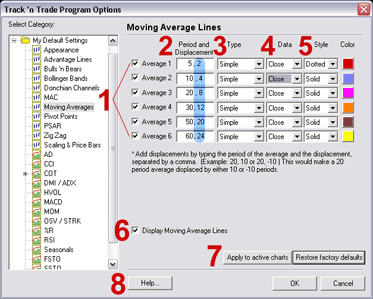Introduction
The moving average, or simple moving average as it is commonly referred
to, represents the average of the last several closing prices. The
moving average is simple to compute, easy to understand, and reliable
under tests. This simplicity is the strength of the moving average.
The basic moving average is computed exactly the same as any other
mathematical average. The most common way of determining the moving
average of a market is to take the closing price over a certain number
of days, add them together, and then divide by the select number of
days.
Interpretation
Generally, moving averages are thought to be indicators of trend. For
example, conventional interpretation is that once prices cross from
below the moving average to above it, the trend is considered up.
On the other hand, if prices go from above the moving average to below
it, the trend of the market is considered down.
The purpose of the simple moving average is to track the progress of the
trend. Moving averages keep you in the trend for potentially a long
time. The moving average gives you an indication of the trend being up
(prices above the moving average) or down (below the moving average).
However, the moving average gives you no indication of the length or
duration of the trend.
Double Moving Average
Introduction
Double moving averages use two different averages in tandem. The first
average is generally a faster reacting average using a shorter period of
time, usually 10 days. The second average is a slower reacting average
that will indicate longer-term price movement.
Using these two averages together helps to alleviate "whipsaws" by
giving a basis of comparison. The faster average breaking above the
slower average is a buy signal, the faster average breaking below the
slower average is a sell signal.
Interpretation
When using two different moving averages the trader gets a clearer
picture of price indications. By combining a slower moving 20-day
average, with a quicker reacting 10-day average, you can see where the
long-term indications are going.
The trend being your friend, until it ends, you would sell once the
faster moving average crosses below the slower trend because that's an
indication of change in trend. Near-term prices should be rising at a
greater rate than longer-term prices in a good upward trending market,
and vice versa for a down trend.
Triple Moving Average
Introduction
The system of triple moving averages is employed by plotting three
different moving averages together. The first of these averages is a
faster average that only looks at the short-term price direction. The
second average is a medium average that reacts to a longer period of
time, but not as long as the final average. The third average is the
slowest to react, because it takes an average of the longest period of
time.
Interpretation
A 10, 20, and 40 day moving average system would be considered a triple
moving average. The first average, the 10-day, is the quickest to move
when prices show a change. The second average, the 20-day, is the medium
average that does not show change until the prices have moved for a
longer period of time. Finally the slowest moving of the averages is the
40-day. This slow average will not indicate a difference until prices
have made a significant move. Shorter-term moving averages, being more
sensitive to changes in price, are said to follow the trend more
closely. The middle or medium average would follow less closely and the
slowest or least sensitive average would lag the most.
The use of the triple moving average is to buy when all three averages
move to be in an upward trend or to sell when these averages are in a
downtrend. The upward trend appears when the fastest average is higher
than both of the other averages, the medium is above the slowest, and
the longer term moving average is on the bottom.
This look would be reversed for a strong down trend with slow average on
top, followed by the medium average, and the fastest on bottom.
Calculation
Parameters:
 |
Period1 (4) - the number of bars, or
interval, used to calculate the first moving average. |
 |
Period2 (9) - the number of bars, or
interval, used to calculate the second moving average. |
 |
Period3 (18) - the number of bars,
or interval, used to calculate the third moving average.
|
Formula:
The formula to calculate a moving average is as follows:
Mat = (P1 +... + Pn) / n
Mat: The moving average for the current period,
Pn: The price for the nth interval
n: The length of the moving average. Compute the average of the past n intervals using the price specified
for that period. Now use real values to compute a five interval moving
average. If you assume the following prices, the calculations are:
MA = (7380 + 7375 + 7385 + 7390 + 7395) / 5
= 36925 / 5
= 7385
Moving
Average Displacements
Period and Displacement: Define the period interval for the
moving average lines and Displacements. To add displacement in the period box,
type the period value first followed by a comma and then the
displacement value. (Example: 10, 20) In the example above you can see
that we have highlighted the displacement values in blue.

Customizing the Moving Average lines
To further change the settings of this indicator, open the Program Options
screen by clicking the "Program Options" button located on the main
Toolbar.

See the
Program Options section for more details on changing the
settings.
Back To Top |